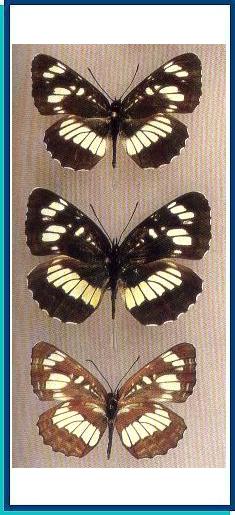LEPIDOPTERA
N Y M P H A L I D A E Swainson, 1827
NEPTIS Fabricius, 1807
Neptis rivularis Scopoli, 1763
Neptis rivularis Scopoli, 1763

• TYPE LOCALITY. Austria, Graz.
•SYNONYMS: lucilla ([Denis et SchiffermuUer], 1775): coenobita (Goeze, 1779); camil-la(Esper, [1777]): innominatus (Lewin, 1795);JridoliniFruhstorfer, 1907.
• RANGE. Temperate belt of the Palaearctic Region.
•DISTRIBUTION AND VARIATION. The nominotypical taxon flying in the European part and Siberia. The ssp. magnata [Heyne], [1895] (= synetairus Fruhstorfer, 1907; = bergmani Bryk, 1942) differs by the well-developed white marking, two white submarginal lines on the UPF and some other peculiarities; it was described from mountains of the Lake Baikal region, Siberia and reaches the Amur and Ussuri regions, Sakhalin and the Kuriles in the east. The ssp. ludmiUa Herrich-Schaffer, 1856, with reduced white markings, inhabits the Caucasus and Transcaucasia, the Pamirs-Alai, the Tian-Shan and the Altais. Considerable variability of the white pattern in this species is noteworthy. There are specimens with only minor remains of white spots. Virtually any part of the area appears to support butterflies which are either not distinguished from the nomino-typical form or are transitional, therefore any distribution limits between the subspecies are highly conventional if any.
•HABITATS AND BIOLOGY. River and stream valleys, open landscapes of forest-steppe regions up to 1,800 m a.s.l. Flight period: June to August, bivoltine in the south. Females laying eggs one by one on tips of leaves. Larvae hiding in convolute leaves. Hibernation as instar 3 larvae. Host plants in Siberia (Kurentzov, 1970; Korshunov & Gorbunov, 1995): Spiraea salicifolia, S. hypericifolia, S. crenata, S. aquilegifolia, Filipendula ulmaria; in the lower flow region of Volga River (Dantchen-ko & Nikolaevsky, in press): Spiraea hypericifolia.
• SIMILAR SPECIES. Neptis sappho: with two white bands on UPH.
Photo and text: Guide to the BUTTERFLIES OF RUSSIA and adjacent territories Volume 2. PENSOFT, Sofia - Moscow. 2000